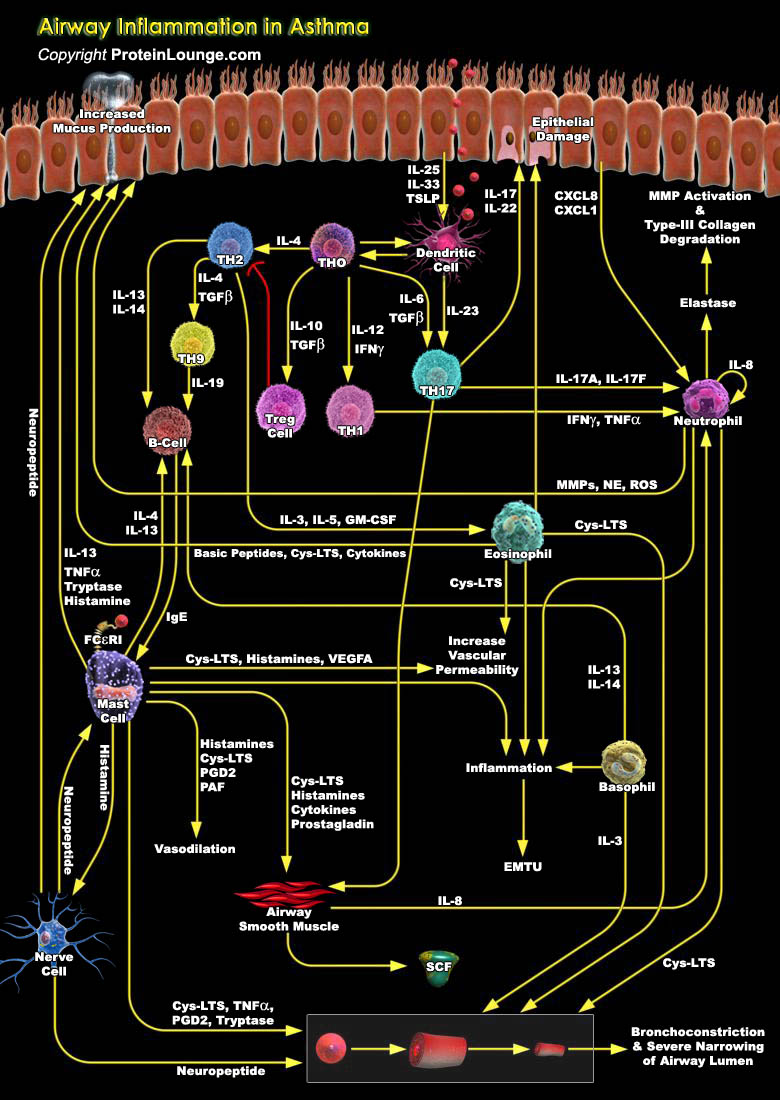
Asthma is a complex, chronic inflammatory lung disease which is characterized by persistent airway inflammation and airway wall remodeling, that includes the structural changes in the airway wall, epithelial cell shedding, hyperplasia and hypertrophy of the ASM (airway smooth muscle) bundles, basement membrane thickening and increased vascular density. Airway wall remodeling starts early in the pathogenesis of asthma [Ref.1]. It originates from complex interactions between genetic factors and environmental agents such as aeroallergens and respiratory viruses [Ref.2]. In the airway lumen, TSLP, IL-25, and IL-33 acts directly on dendritic cells and then it processes the antigenic molecules and present them to Th0 (naïve T helper cells) [Ref.3]. Further, Th0 get[..]
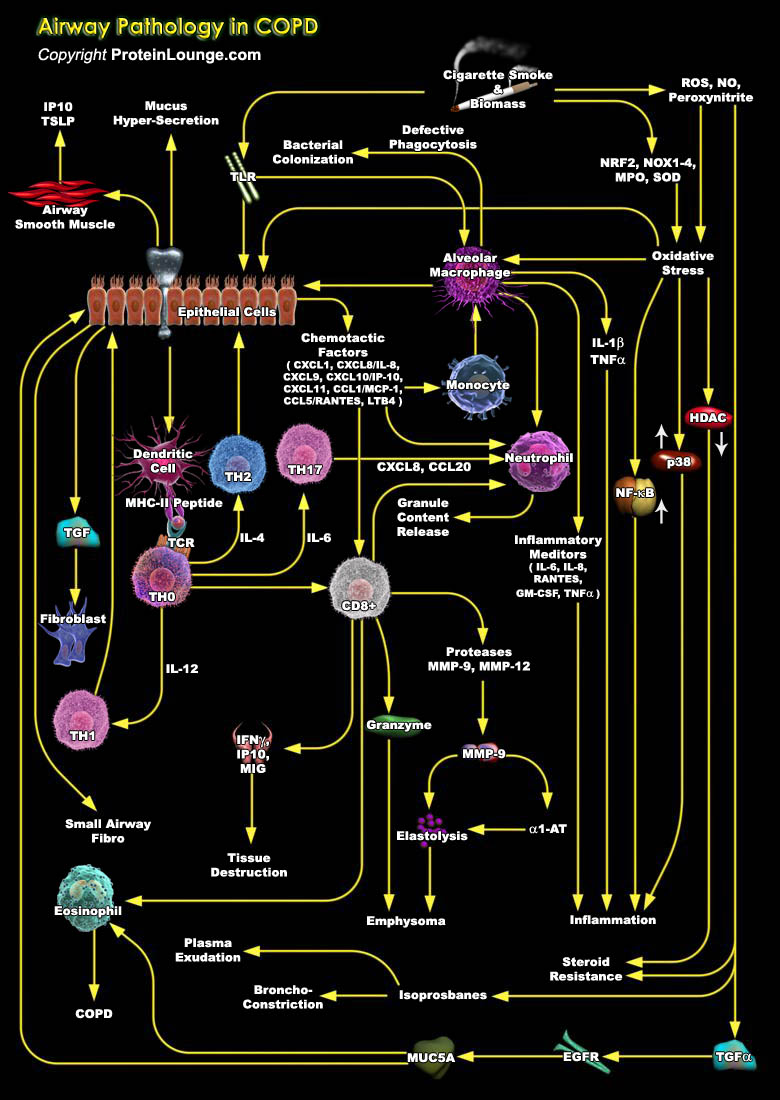
Chronic obstructive pulmonary disease (COPD) is a major global health problem that is becoming preva¬lent, particularly in developing countries [Ref.1]. It is one of the most common diseases in the world, with a lifetime risk estimated to be as high as 25%, and now equally affects both men and women [Ref.2]. COPD is greatly under¬ diagnosed and often diagnosed late in its course, so there are vigorous attempts to increase awareness of this dis¬ease and to promote the use of spirometry to identify more patients [Ref.3]. COPD involves chronic inflammation of the periph-eral airways and lung parenchyma, which leads to pro¬gressive narrowing of the airways and shortness of breath [Ref.4.]Cigarette smoke (and other irritants) activates macrophages and[..]
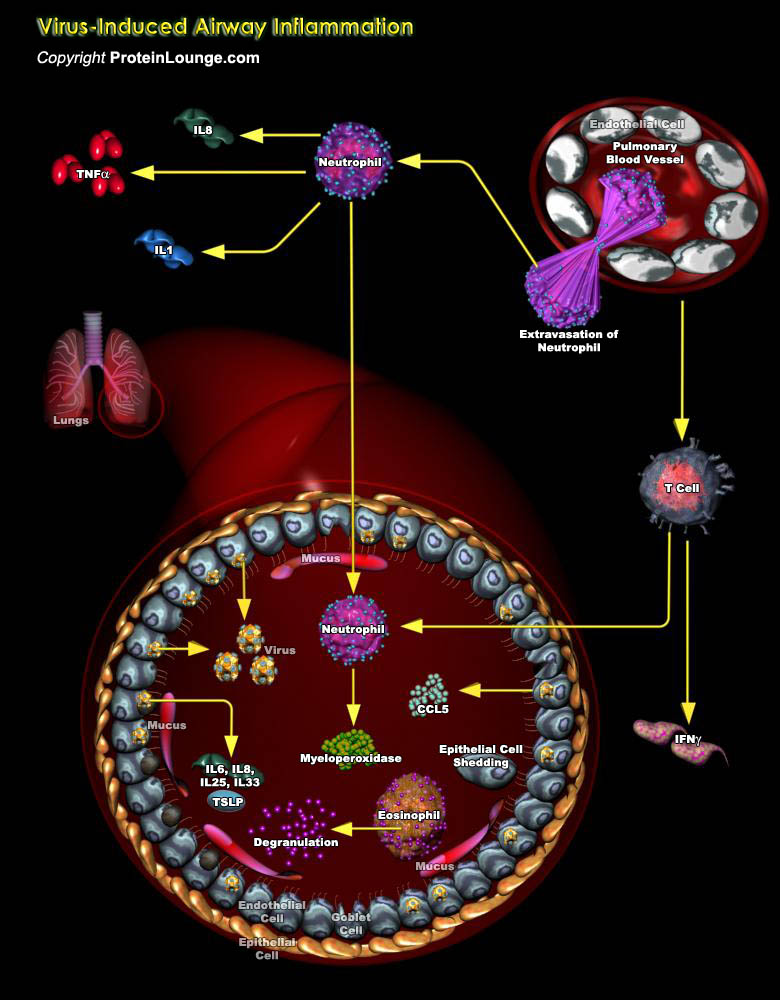
More than 200 different types of viruses, such as human Rhinovirus (HRV), human Metapneumovirus (HMPV), Respiratory Syncytial Virus (RSV), and human Parainfluenza Virus (HPIV), are known to cause acute respiratory illness. Virus-induced cytokine production and inflammatory cell activation are instrumental in the development of neurogenic inflammatory responses, and these combined factors increase bronchoconstriction in response to allergens or irritants. Respiratory viruses primarily infect and replicate within airway epithelial cells. During the replication process, the cells release antiviral factors and cytokines that alter local airway inflammation and airway niche. In a healthy airway, the inflammation normally leads to type 1 inflammatory responses consisting of[..]
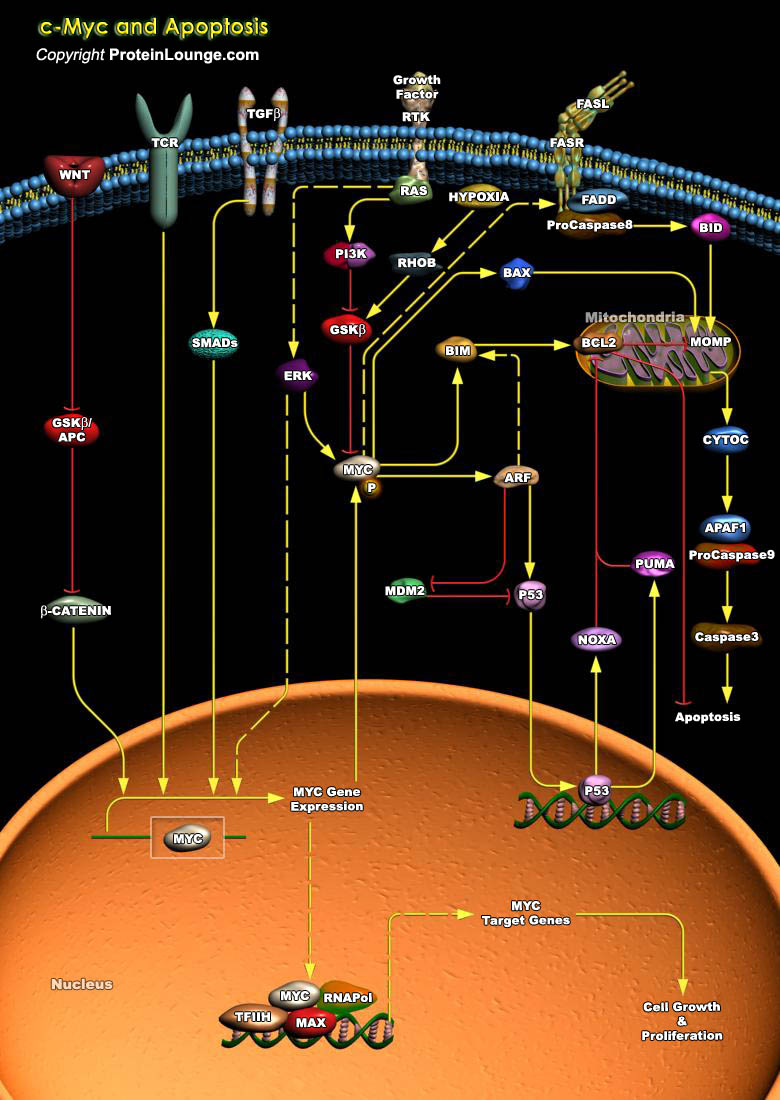
Many proto-oncogenes participate in the regulation of apoptosis and closely intertwined with their actions are various growth factors and other genes that participate in the control of cellular growth. The proto-oncogene c-Myc encodes a transcription factor c-Myc that plays a critical role in multiple cellular processes including cell growth, proliferation, differentiation, and apoptosis. Expression of c-Myc is rapidly induced by mitogens and is down regulated during differentiation. c-Myc activity is sufficient to drive cells into the cell cycle in the absence of growth factors but also induces apoptosis when survival factors are missing. Deregulated expression of c-Myc is associated with a wide array of human cancers. Thr-58 is a major phosphorylation site in c-Myc[..]
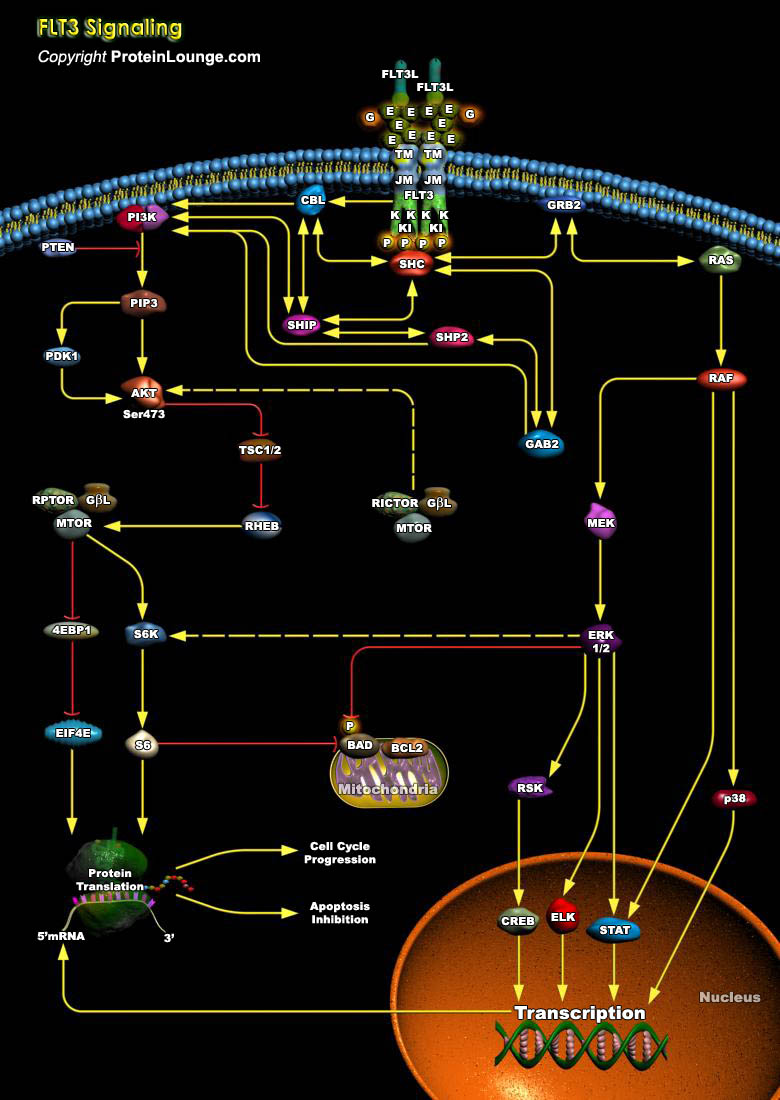
FLT3 (Fms-like Tyrosine Kinase-3), also known as FLK2 (Fetal Liver Kinase-2) and STK1 (human Stem Cell Kinase-1) was originally isolated as a hematopoietic progenitor cell-specific kinase, and belongs to the Class-III RTK (Receptor Tyrosine Kinase) family to which c-Fms, c-Kit, and the PDGFR (Platelet Derived Growth Factor Receptor) also belong (Ref.1). Normal expression of FLT3 is restricted to haemopoietic progenitor cells in the bone marrow, thymus and lymph nodes, but is also found on other tissues such as placenta, brain, cerebellum and gonads. Aberrantly expressed FLT3 is observed at high levels in a spectrum of hematologic malignancies including 70% to 100% of AML (Acute Myelogenous Leukemia), B-precursor cell ALL (Acute Lymphoblastic Leukemia), a fraction of[..]
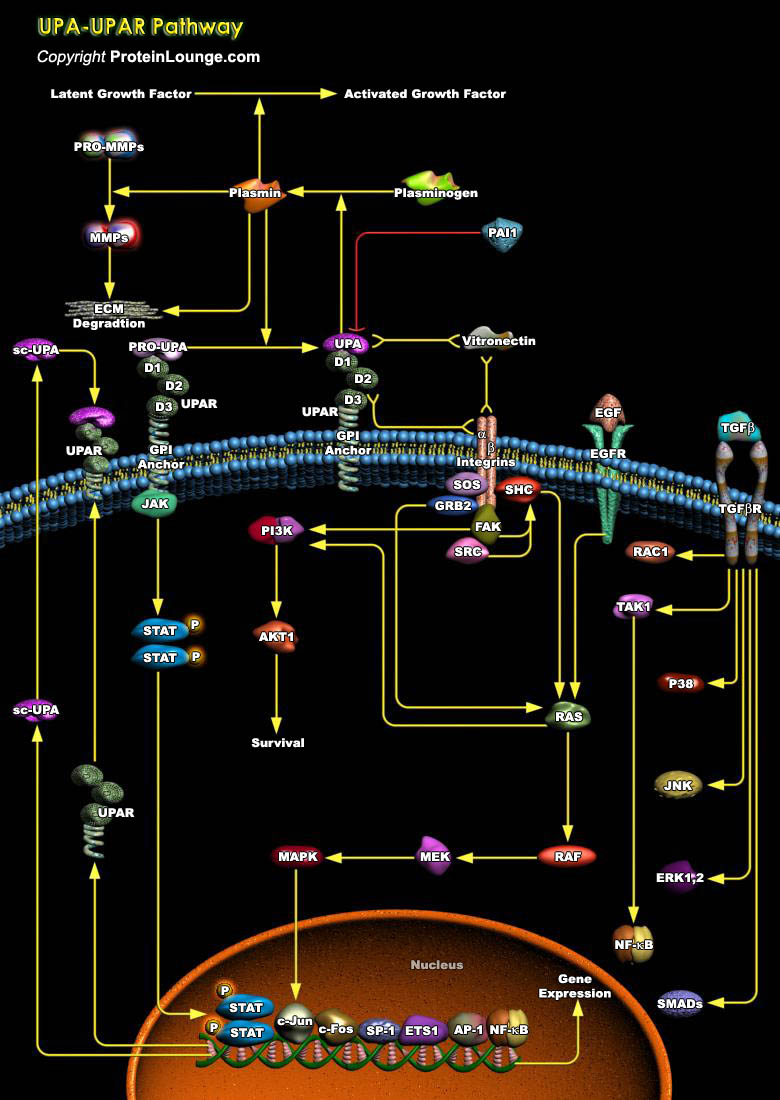
Proteases are expressed by normal cells in tissue remodeling events and also during pathological events such as tumor invasion and metastasis. Some of the proteases including serine proteinases and MMPs (Metalloproteinases) have been implicated in remodeling of the ECM (Extracellular Matrix) in lung injury and lung neoplasia. These enzymes influence inflammatory cell traffic or cancer cell invasiveness via the breakdown of basement membranes and ECM. Plasmin, a serine protease, is involved in the dissolution of ECM and basement membrane during tissue degradation. This protease is generated via the action of plasminogen activators such as Urokinase (UPA, Urokinase-type Plasminogen Activator) or Urokinase (tissue Plasminogen Activator) and can influence tissue remodeling[..]
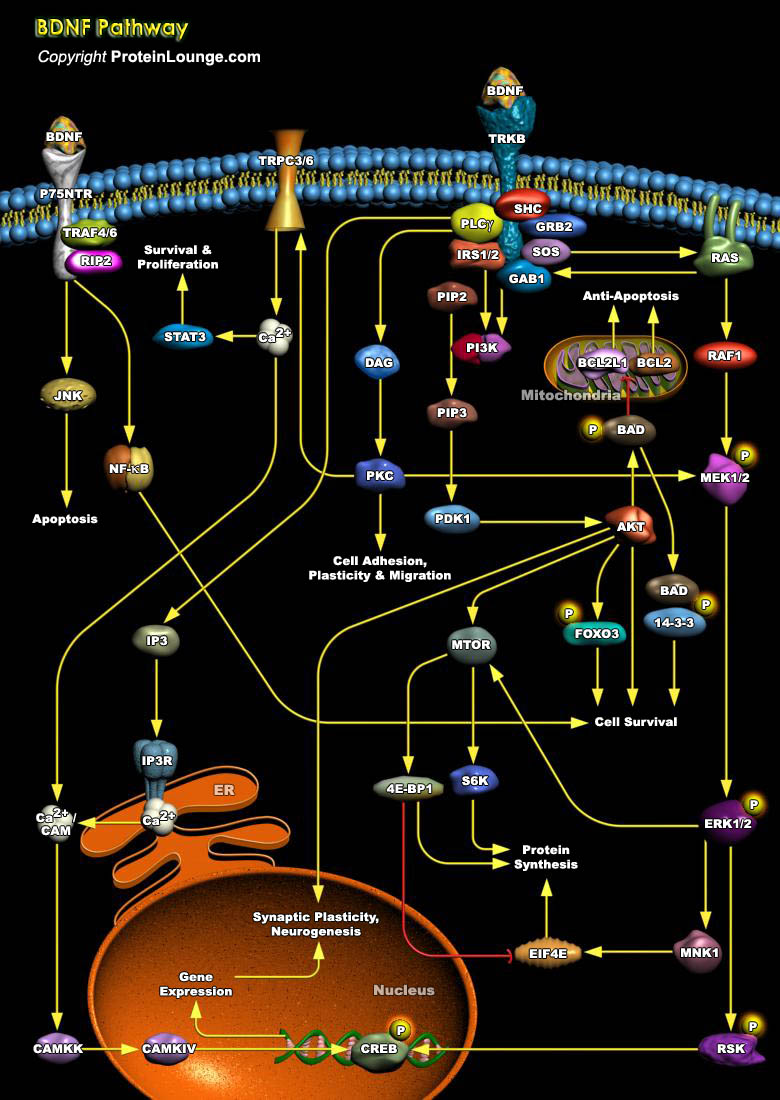
Neurotrophins are an important class of signaling molecules in the brain responsible for axon targeting, neuron growth, maturation of synapses during development, and synaptic plasticity. This family of molecules includes NGF (Nerve Growth Factor), BDNF (Brain Derived Neurotrophic Factor), NT3 (Neurotrophin-3) and NT4 (Neurotrophin-4) [Ref.1].Brain-derived neurotrophic factor (BDNF) is one of the neurotrophic factors that support differentiation, maturation, and survival of neurons in the nervous system and shows a neuroprotective effect under adverse conditions, such as glutamatergic stimulation, cerebral ischemia, hypoglycemia, and neurotoxicity. BDNF stimulates and controls growth of new neurons from neural stem cells (neurogenesis) and BDNF protein and mRNA have[..]
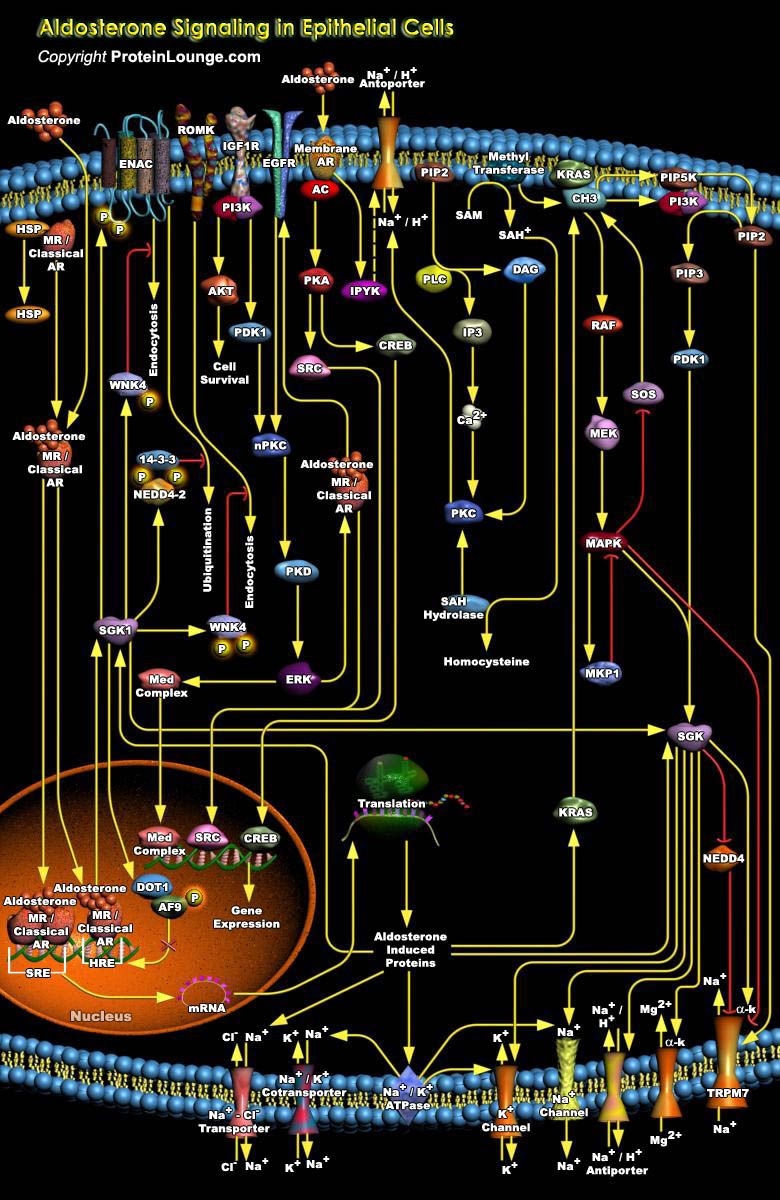
Sodium transport across the tight epithelia of Na+ reabsorbing tissues such as the distal nephron and colon is the major factor determining total body Na+ levels, and thus, long term blood pressure. Aldosterone, a steroid hormone that is primarily produced in the outer layer of the adrenal cortex, maintains total organism sodium balance in all higher vertebrates. Principally, in humans, aldosterone is involved in the regulation of electrolyte and water balance through its effects on ion transport in epithelial cells. Electrically tight epithelial monolayers, such as the renal distal tubule and collecting duct system, distal colon, and those in salivary glands, are considered classic aldosterone target tissues. Aldosterone plays a major role in Na+, K+, and H+[..]
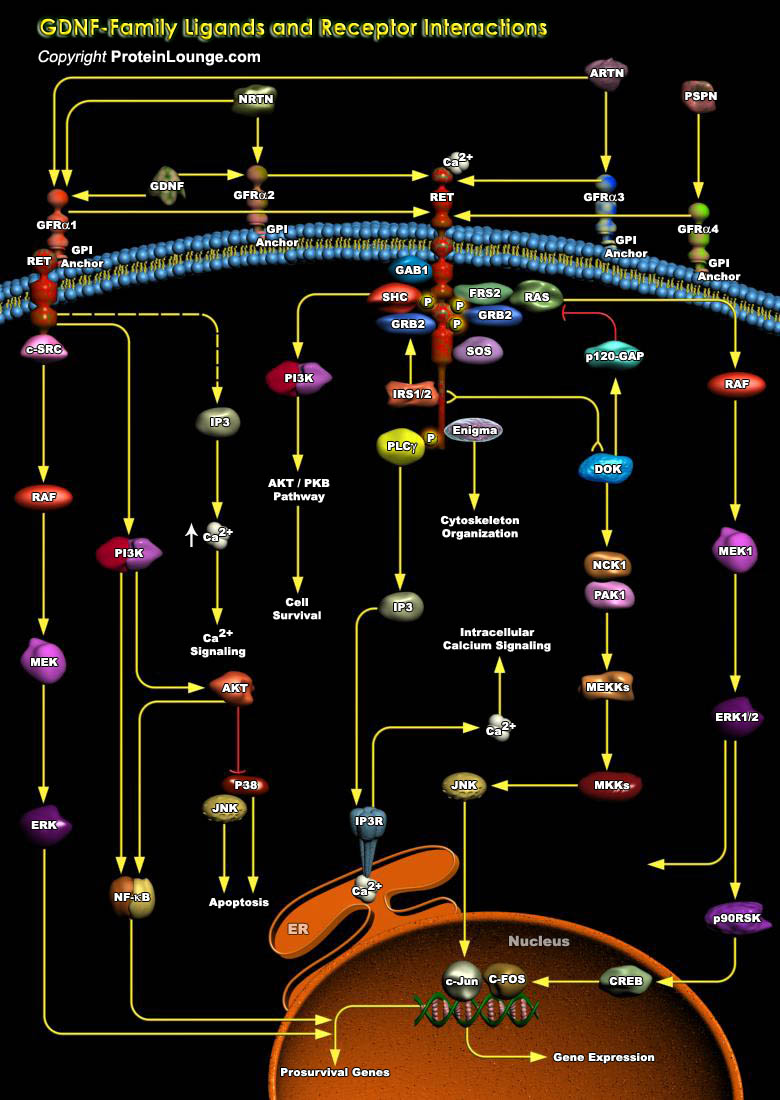
Neurotrophic factors are a broad set of peptide growth factors that tightly regulate many critical aspects of the ontogeny of neurons, such as the number of neurons in a given population, neurite branching and synaptogenesis, adult synaptic plasticity and maturation of electrophysiological properties. Neurotrophic factors include Neurotrophins, Neurokines and GDNF (Glial-cell-line-derived Neurotrophic Factor) family ligands (GFLs). GDNF family, consisting of GDNF, NRTN (Neurturin), ARTN (Artemin) and PSPN (Persephin) are distant members of the TGF-Beta (Transforming Growth Factor-Beta) superfamily that maintain several neuronal populations in the CNS (Central Nervous Systems), including midbrain dopamine neurons. In addition, GDNF, NRTN and ARTN support the survival[..]
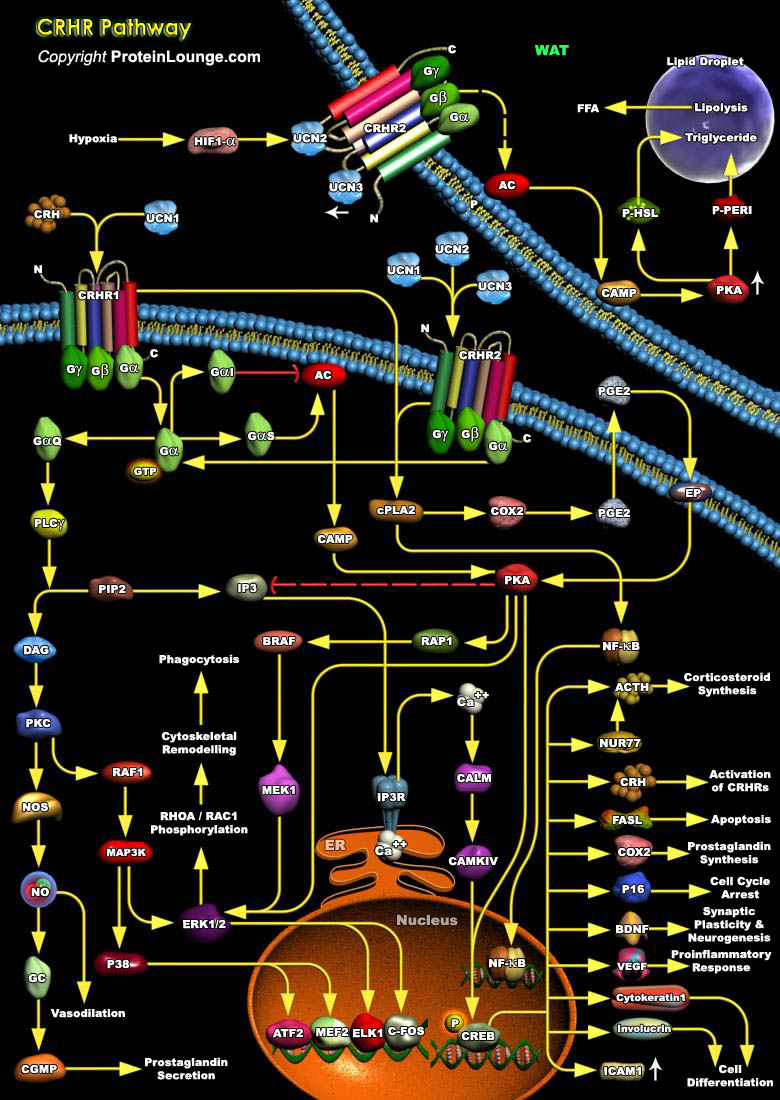
CRH (Corticotropin-Releasing Hormone) and related peptides play a major role in coordinating the behavioral, endocrine, cardiovascular, autonomic and immune mechanisms that allow mammals to adapt under both basal and stressful conditions. Their actions are mediated through activation of two types of GPCRs (G-Protein-Coupled Receptors): CRHR1 (CRH Receptor-1) and CRHR2 (CRH Receptor-2) encoded by separate genes. CRH and CRH-related peptides and their receptors are widely distributed in the central nervous system, and in a variety of peripheral tissues, including the immune, cardiovascular and reproductive systems, adrenals, lungs, liver, stomach, pancreas, small intestine, skin tissues, and also in some types of human tumors. The ubiquitous distribution of CRH-related[..]
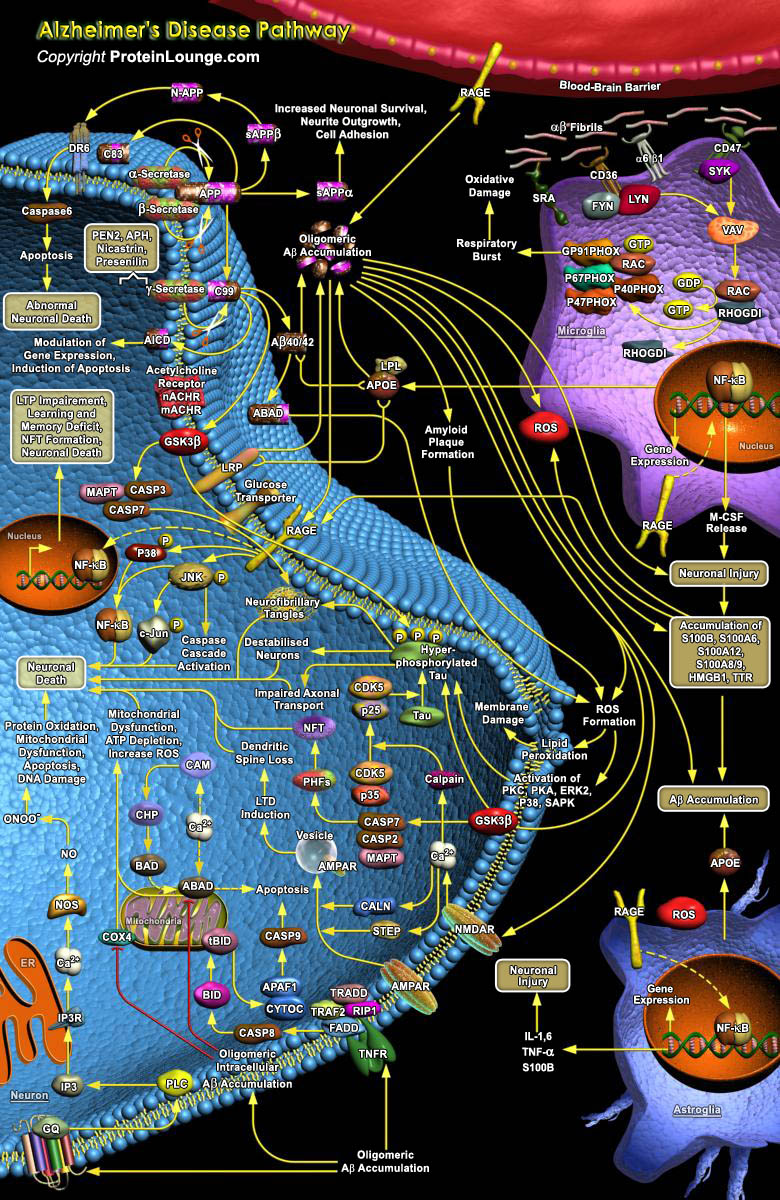
AD (Alzheimer's Disease) is a neurodegenerative disorder leading to amnesia, cognitive impairment, and senile dementia. Two types of lesions characterize the disease: SPs (Amyloid or Senile Plaques) resulting from the extracellular aggregation of ABeta (Amyloid Beta) peptide, which is derived from a ubiquitous type I transmembrane protein named APP (Amyloid Precursor Protein), and NFTs (Neuro-Fibrillary Tangles) composed of intraneuronal bundles of PHF (Paired Helical Filaments). PHF result from the aggregation of pathologic Tau proteins, named PHF-Tau1. Both lesions extend progressively to neocortical brain areas during the course of Alzheimer Disease. The link between Amyloid deposits and NFTs is not yet clear. The vast majority of cases of Alzheimer Disease are[..]
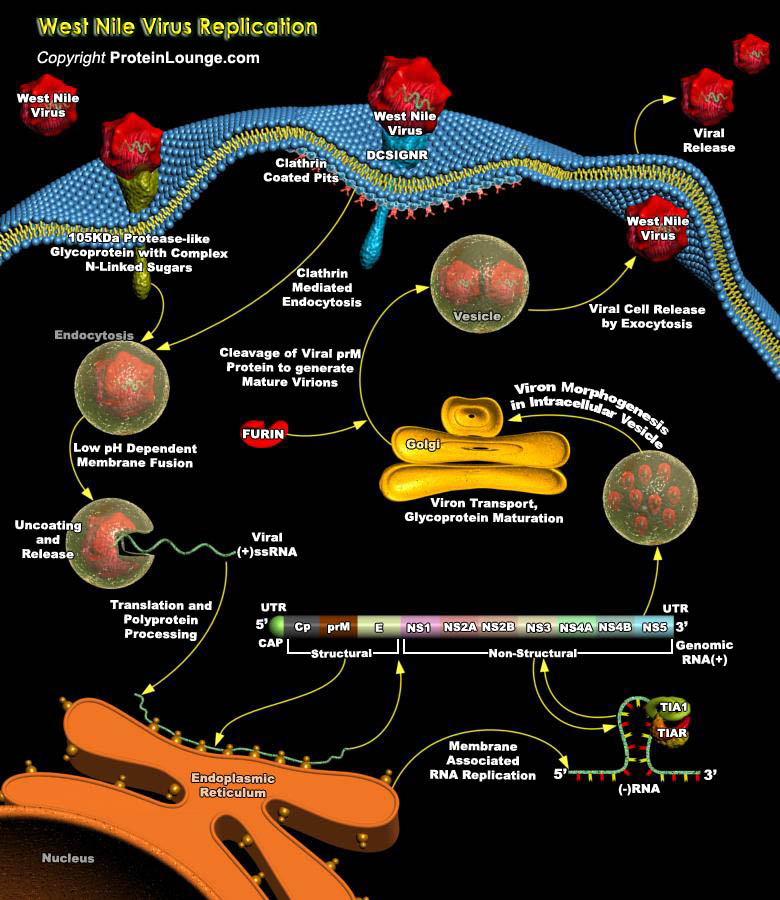
WNV (West Nile Virus) is a single-stranded positive-polarity enveloped virus with icosahedral symmetry virus and the etiologic agent of West Nile encephalitis. It is a member of the Japanese encephalitis virus antigenic group within the family Flaviviridae, which can cause fatal encephalitis associated with damage to the CNS (Central Nervous System) in humans and animals. Wild birds are the natural reservoir (amplifying) hosts, and WNV transmission cycle primarily involving Culex sp mosquitoes. Initially isolated in 1937, it is now recognized as one of the most widely distributed flaviviruses, endemic in Africa, Europe, the Middle East, and parts of Asia. Since 1999, the virus has been recognized in North America by causing an epizootic among birds and horses[..]

